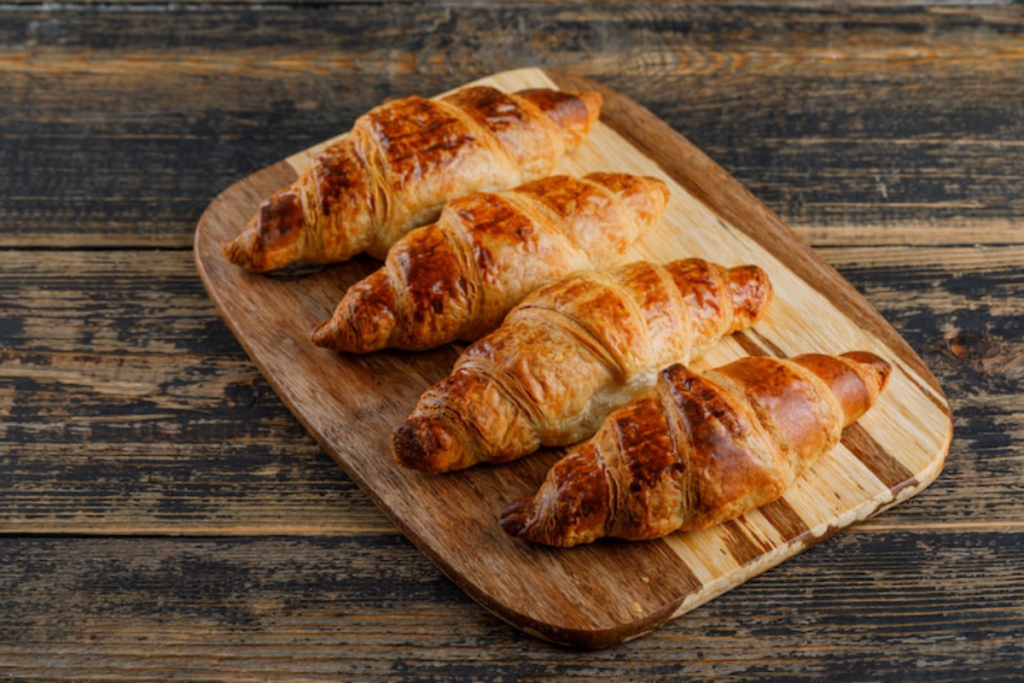What makes a croissant so irresistible? The flaky, buttery layers that melt in your mouth? Or perhaps it’s the golden, crisp exterior that promises a delicious bite every time? The secret of the croissant lies in more than just ingredients—it’s a perfect balance of technique, precision, and time.
In this 3,000-word guide, we’ll uncover the mystery behind the croissant and explore the steps, secrets, and tips that go into creating this iconic French pastry. From the right type of butter to the magic of lamination, let’s dive deep into the art of making a croissant.
The History Behind the Croissant
Before we reveal the secret of the croissant, it’s important to understand its origins. The croissant, though widely regarded as a French delicacy, has a story that traces back to Austria.
Austrian Roots of the Croissant
The croissant’s earliest predecessor is believed to be the Austrian kipferl, a crescent-shaped pastry that dates back to the 13th century. Unlike croissants, kipferl were more bread-like, denser, and less buttery. However, their crescent shape became the foundation of what would eventually evolve into the croissant.
It wasn’t until the 19th century that the croissant made its way to France, where French bakers took the concept and transformed it into the flaky, buttery pastry we know and love today. The croissant’s popularity exploded in France, and it became a symbol of French pastry craftsmanship.

The Essential Ingredients in a Croissant
Understanding the secret of the croissant starts with knowing the ingredients. While a croissant may seem simple with its short list of ingredients, each one plays a crucial role in achieving the perfect texture and flavor.
Flour: The Backbone of the Dough
Flour forms the foundation of any croissant dough. Pastry chefs typically use high-protein bread flour, which has a higher gluten content than all-purpose flour. This helps create the dough’s strength, allowing it to hold up through the rolling and folding process without tearing.
Butter: The Heart of the Croissant
Butter is arguably the most important ingredient in a croissant. The secret to the croissant’s signature flaky layers lies in the butter that is layered between sheets of dough during the lamination process. Using high-quality, unsalted butter is essential for achieving the best flavor and texture.
French butter, known for its higher fat content (around 82%), is often preferred because it gives the croissant a richer, creamier flavor and a superior texture.
Yeast: Giving the Dough Life
Yeast is another critical component that gives croissants their light and airy texture. The yeast causes the dough to rise during proofing, creating pockets of air that expand during baking and contribute to the croissant’s delicate, flaky structure.
Milk and Sugar: Adding Flavor and Tenderness
Milk adds richness and tenderness to the dough, while a small amount of sugar balances the flavors and helps create the golden-brown exterior during baking. The sugar also feeds the yeast, aiding in fermentation and giving the dough a subtle sweetness.
Salt: Balancing Flavors
Salt may seem like a minor addition, but it plays a vital role in enhancing the overall flavor of the croissant. It balances the sweetness and adds depth to the buttery taste.
The Secret Technique: Lamination
The real secret of the croissant lies in the technique known as lamination. This process of folding and rolling butter into the dough is what creates the signature layers that puff up into flaky, buttery perfection.
What Is Lamination?
Lamination is the technique of folding butter into the dough multiple times to create hundreds of thin layers. Each time the dough is folded, it’s rolled out again to sandwich more butter between the layers. This is repeated several times, creating a structure that, when baked, becomes light and airy with a delicate, crispy exterior.
Step-by-Step Process of Laminating Croissant Dough
Achieving the perfect lamination takes patience, precision, and attention to detail. Here’s a breakdown of the key steps involved in the process:
- Preparing the Dough: After mixing the dough, it’s rolled into a rectangle and chilled to make it easier to work with. The dough should be firm but pliable, ensuring it doesn’t tear when rolling.
- Incorporating the Butter: The butter is flattened into a square and placed on the dough, which is then folded over it like an envelope. This is the beginning of the lamination process.
- First Fold (Single Turn): The dough is rolled out and folded in thirds, like folding a letter. This creates the first set of layers.
- Chilling the Dough: The dough is chilled between folds to keep the butter from melting and to relax the gluten in the dough. Keeping the butter cold is essential to achieving flaky layers.
- Second and Third Folds (Double Turns): The dough is rolled out again, folded in half, and then folded once more. After each fold, the dough is chilled before being rolled out for the next turn.
- Shaping the Croissants: Once the final folds are complete, the dough is rolled out one last time and cut into triangles. These triangles are then rolled into the traditional crescent shape.
- Proofing: The shaped croissants are allowed to proof, or rise, before baking. This step is crucial for developing the light, airy structure inside the croissant.
The Science Behind the Flaky Layers
The secret to the croissant’s signature flakiness lies in the interaction between the butter and the dough during baking. As the croissant bakes, the butter trapped between the layers of dough melts, creating steam. This steam expands, pushing the layers of dough apart and causing the croissant to puff up.
The alternating layers of dough and butter are what give the croissant its distinct texture. Each bite is a combination of crispy outer layers and soft, buttery inner layers. The process is intricate, but it’s the magic behind the croissant’s deliciousness.
Temperature Control: A Crucial Part of the Secret
The secret of the croissant doesn’t just lie in the ingredients and techniques—it’s also about mastering temperature control. Ensuring that the butter remains cold throughout the lamination process is key to achieving a perfect croissant.
Cold Butter for Lamination
The butter used in croissant dough must be cold but pliable. If it’s too cold, it can break and ruin the lamination process. If it’s too warm, it will melt into the dough, preventing the formation of distinct layers. Keeping the dough and butter cold during lamination is essential for creating the light, flaky texture croissants are known for.
Baking Temperature
Once the croissants have been shaped and proofed, they need to be baked at the right temperature to ensure even cooking and browning. Croissants are typically baked at a high temperature (around 400°F or 200°C) to encourage the butter to steam quickly, creating puffed layers, while also giving the outside a beautiful golden color.
The Role of Patience: Letting the Dough Rest
Patience is another crucial aspect of the secret of the croissant. From chilling the dough between folds to allowing the croissants to rise properly before baking, every step requires time and care.
Why Resting the Dough Matters
Letting the dough rest in the refrigerator between folds serves two purposes. First, it allows the butter to firm up, making it easier to roll out without tearing the dough. Second, resting gives the gluten in the dough a chance to relax, which prevents the dough from becoming too tough and chewy.
Proofing the Croissants
After shaping the croissants, they need time to proof, or rise, before baking. During this stage, the yeast ferments and produces gas, which helps create the croissant’s light, airy texture. Rushing this process can result in dense, heavy croissants that lack the delicate layers we associate with a perfect pastry.
The ideal proofing environment is warm but not too hot. Too much heat can cause the butter to melt prematurely, while too little heat will prevent the dough from rising properly.
The Final Bake: Bringing Everything Together
The last step in unlocking the secret of the croissant is the bake. All the preparation, folding, and resting lead up to this moment, and getting it right is essential for achieving the perfect croissant.
The Importance of Egg Wash
Before the croissants go into the oven, they’re brushed with an egg wash (a mixture of egg and a little water or milk). This step gives the croissants their shiny, golden-brown crust. The egg wash not only adds to the appearance but also enhances the flavor by creating a slightly crispy exterior.
Baking Time and Temperature
Croissants are baked at a relatively high temperature—around 400°F (200°C). The high heat helps the butter inside the dough quickly create steam, which causes the layers to puff up. The result is a perfectly crisp exterior and a soft, light interior.
Most croissants take about 15-20 minutes to bake, though this can vary depending on the size of the croissants and the oven. Once they’re golden brown and sound hollow when tapped on the bottom, they’re ready to come out of the oven.
Secrets to a Perfect Croissant at Home
Now that you know the secret of the croissant, you might be wondering how to achieve that perfect pastry in your own kitchen. Here are a few tips to ensure success:
Use High-Quality Butter
The quality of butter makes a significant difference in the final product. European-style butter, with its higher fat content, will give your croissants a richer flavor and flakier texture.
Don’t Rush the Process
Croissant-making is a time-intensive process that requires patience. Allow plenty of time for chilling, folding, and proofing the dough. Rushing through these steps can compromise the texture and flavor of your croissants.
Keep Everything Cold
Maintaining the right temperature is key to success. Keep the butter cold during lamination, and be sure to chill the dough between folds to prevent the butter from melting into the dough.
Experiment with Fillings
While traditional croissants are delicious on their own, don’t be afraid to get creative with fillings. Almond croissants, pain au chocolat (chocolate-filled croissants), and ham and cheese croissants are just a few variations that you can experiment with at home.
Conclusion: The Secret to Mastering the Croissant
The secret of the croissant lies in the meticulous process of lamination, the careful use of high-quality butter, and the patience to let the dough rest and rise. Achieving the perfect croissant requires time and skill, but the result is a pastry that is truly a work of art—flaky, buttery, and utterly delicious.
Whether you’re a pastry enthusiast or someone who simply enjoys a good croissant with your morning coffee, understanding the intricacies of this pastry will give you a deeper appreciation for the craftsmanship behind it. Now that you know the secret of the croissant, why not try making your own and experience the magic for yourself?
